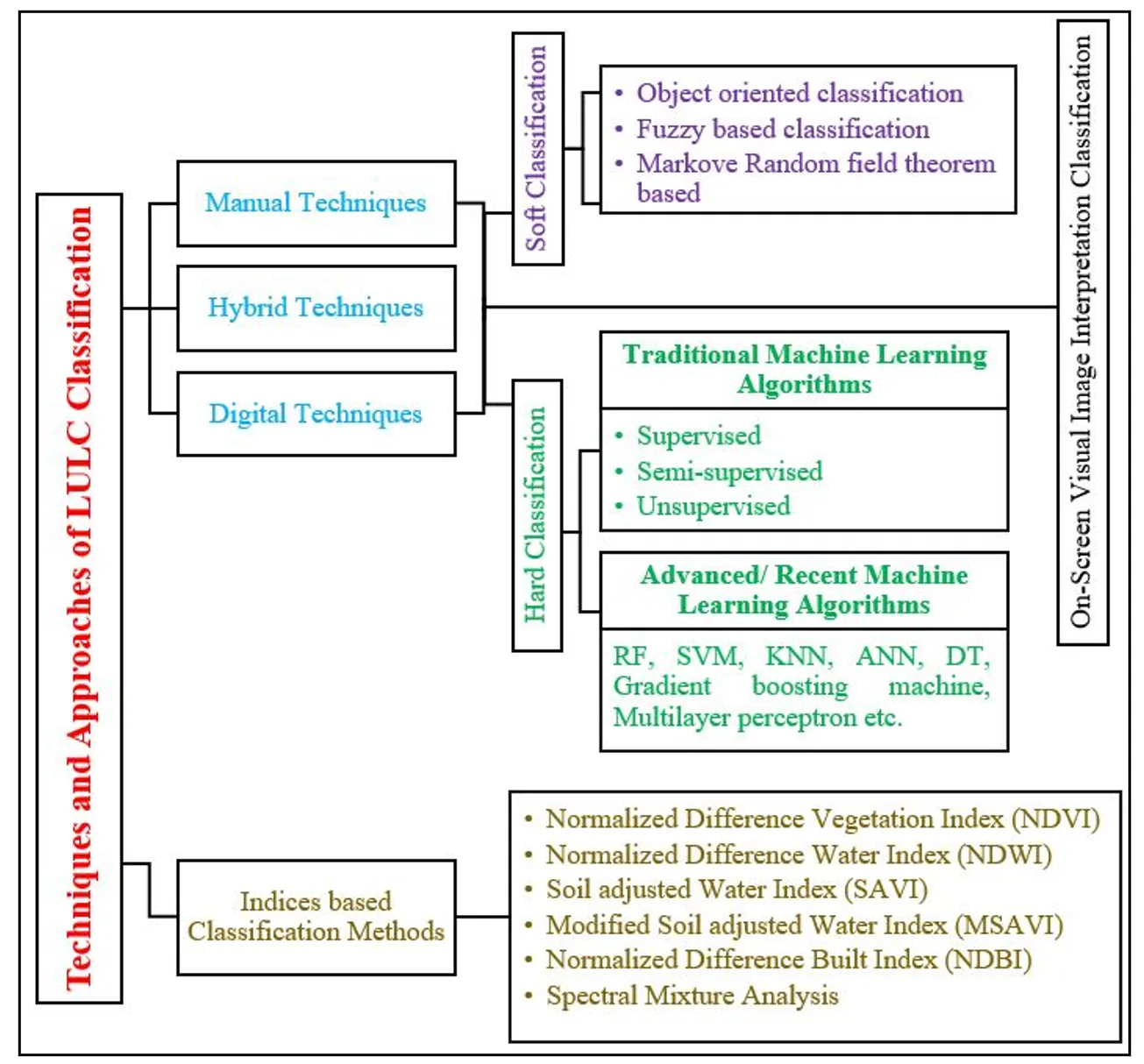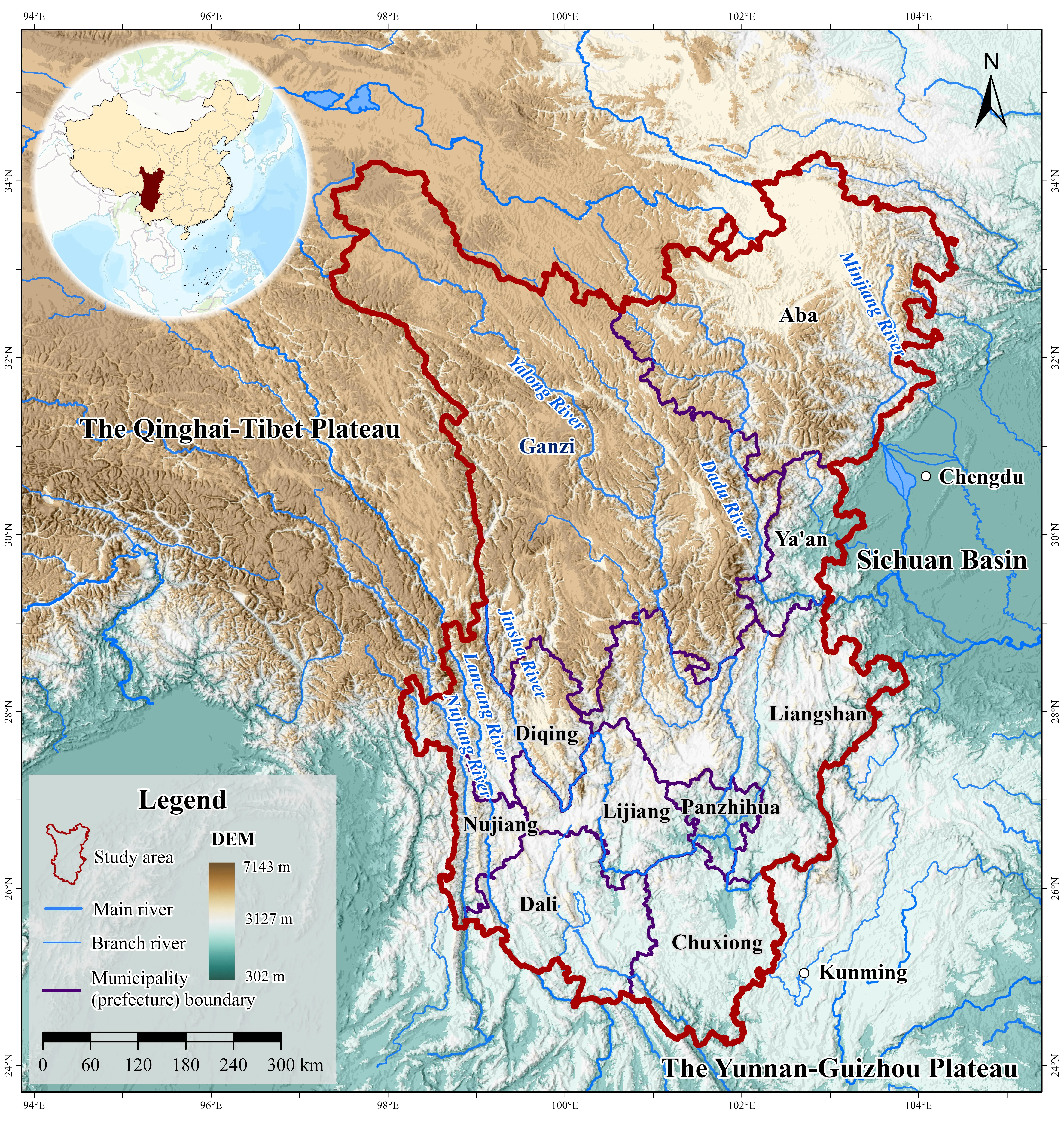Open Access
Article
26 September 2025Land Use and Land Cover Assessment of Jalandhar, India: A Comparative Analysis of Machine Learning and Visual Interpretation
For the sustainable management of natural resources and to understand how the climate affects the landscape, accurate land use and land cover (LULC) classification is essential. Robust classification techniques and high-quality datasets are necessary for precise and effective LULC classification. The effectiveness of various combinations of satellite data and classification techniques must be carefully evaluated to help choose the optimal strategy for LULC classification, given the growing availability of satellite data, geospatial analysis tools, and classification techniques. This study focuses on the LULC classification of Jalandhar, Punjab, India, using machine learning (ML) algorithms and visual image interpretation. Sentinel-2 satellite data, with its high spatial and spectral resolution, has been utilized for feature extraction and classification. Python was employed for implementing various ML algorithms, including Random Forest (RF), Support Vector Machine (SVM), K-Nearest Neighbor (KNN), Gradient Boosting (GB), Multi-Layer Perceptron (MLP), and Decision Tree (DT), while ArcGIS was used to classify LULC using visual image interpretation and for maps preparation. Agriculture was the dominant class across all methods, with GB estimating 1774.26 sq.km, followed by plantation (268.13 sq.km) and built-up areas (171.76 sq.km). Waterbodies were mapped with high precision due to their distinct spectral features, with estimates ranging from 18.34 sq.km (GB) to 26.05 sq.km (Visual interpretation). Among all models, GB outperformed others with the highest overall accuracy (95.0%) and a kappa value of 0.94, followed by RF (94.2%), and SVM (93.8%). Visual interpretation achieved a comparative accuracy of 90.1%, though it showed limitations in distinguishing spectrally mixed classes like plantation and built-up. This study concludes that while Visual interpretation remains a useful and accessible method, especially for real-time interpretation, ML-based approaches, particularly GB and RF, offer superior accuracy and reliability. The study highlights the importance of visual interpretation for a better accurate LULC at a regional level; meanwhile, leveraging advancements in ML algorithms in a hybrid approach will enhance the accuracy in many-fold.
Open Access
Article
17 October 2025Bioenergy Technology and Carbon Intensity in U.S. and China: Threshold Roles of Capital Accumulation, Education and Inequality
Bioenergy technology holds significant promise for reducing carbon intensity and fostering sustainable development, yet its impact remains unclear. This article employs both a panel threshold model and a random forest model, analyzing data from the primary administrative regions in the United States and China to explore the threshold effects and regional heterogeneity of bioenergy technology on carbon intensity, where the bioenergy technology is measured using patent data. In the United States, the impact of bioenergy technology on carbon intensity initially shows a positive effect, which later turns negative as per capita capital stock increases. The technology’s inhibitory effect strengthens with higher levels of education but becomes insignificant as the Gini coefficient rises. In China, increasing per capita capital stock shifts the impact of bioenergy technology from negative to insignificant, while higher education levels enhance its inhibitory effect. The Gini coefficient, however, does not significantly affect the impact of technology. Additionally, these threshold effects exhibit notable regional variations. The study provides cross-country evidence of how institutional and structural conditions shape the carbon mitigation effects of bioenergy technology, offering practical insights for policies that combine trade facilitation, education, and inequality reduction with low-carbon energy transitions.
Open Access
Review
23 October 2025Unpacking the Transformative Power of the Rights of Nature: Rethinking Self, Society, and Nature in Environmental Governance in Tanzania
This study examines the transformative potential of integrating the Rights of Nature (RoN) into Tanzania’s environmental governance framework to address persistent ecological degradation, legal marginalization of local communities, and systemic governance gaps. Despite global progress in adopting the Rights of Nature (RoN), where ecosystems are granted legal personhood and communities serve as guardians Tanzania’s legal and institutional frameworks remain predominantly anthropocentric, lacking provisions that recognize nature’s intrinsic value. The primary objective of the study was to critically evaluate the extent to which Tanzania’s current governance systems reflect or exclude RoN principles and to propose transformative pathways grounded in justice, inclusivity, and local knowledge. The study analyzed international legal instruments, Tanzanian statutes, scholarly literature, and case studies using a doctrinal and thematic review methodology. Findings reveal that, despite Tanzania’s comprehensive environmental legislation, such as the Environmental Management Act (2004), key provisions fail to ensure procedural justice and exclude communities from meaningful participation, particularly under Strategic Environmental Assessment regulations. Conversely, local and Indigenous communities such as the Maasai, Chagga, and Zaramo have long practiced ecological stewardship grounded in relational worldviews, echoing RoN values. However, these systems are neither legally recognized nor institutionalized. The study concludes that a shift towards rights-based and transformative governance is necessary to address environmental injustice and ecological decline. It recommends revising legal frameworks to grant ecosystem rights, mandating participatory governance, and embedding Indigenous and local knowledge into environmental policy. Such reforms will not only enhance ecological integrity and local empowerment but also contribute to achieving Tanzania’s commitments under Sustainable Development Goals (SDGs) 13, 15, and 16.
Open Access
Review
28 October 2025Digital Transformation and Circular Economy Integration: Pathways for Sustainable Business Innovation
The accelerating pace of digital transformation has reshaped how industries pursue sustainability, offering innovative ways to integrate environmental responsibility into business strategy. This study examines how digital technologies such as artificial intelligence, blockchain, the Internet of Things, and big data analytics enable the adoption of circular economy principles in sustainable business innovation. Using a systematic literature review of 85 studies published between 2015 and 2025, the research identifies key mechanisms through which digital transformation enhances resource efficiency, extends product lifecycles, and promotes transparent supply chains. The findings show that digitalization strengthens competitiveness and sustainability but presents challenges such as high implementation costs, unequal access to digital infrastructure, and the environmental footprint of information and communication technology systems. The study concludes that aligning digital adoption with organizational culture, governance structures, and supportive policy frameworks is essential for realizing circular economy strategies at scale and achieving resilient, low carbon, and sustainable business models.
Open Access
Article
29 October 2025Solutions of Minimized Agrochemicals Input in the Post Zero-Growth Era: A State-of-the-Art Analysis of the Hengduan Mountains, China
How to further reduce the input of agrochemicals after zero-growth is an important challenge faced by mountainous areas. Up to now, the combined solution for minimized agrochemicals intervention in the post zero-growth era has not been systematically analyzed globally. Here, the Hengduan Mountain regions (HMR) in China, as a case, we estimated the turning points of agrochemicals input intensities using a quadratic equation, as well as integrating policy document analysis and literature review. Results show that the occurred timeline of fertilizer and pesticide use zero-growth in 10 municipalities (prefectures) in the HMR is relatively wide, with a distribution from 2009 to 2019, illustrating that all municipalities (prefectures) have been achieved national goals ahead of 2020 deadline. Thus, the incentive of a series of national-level policies focusing on chemical fertilizers and pesticides has proven effective in achieving the zero-growth target of agrochemicals input in the HMR. However, comparison with major mountainous countries like Germany, Italy, Portugal, Romania, Austria, and Spain etc., there are clearly many opportunities for enhancement in reducing fertilizer and pesticide uses. We present a practical route to minimize agrochemicals application in the HMR through crop rotation-based agro-biodiversity solutions, organic alternative-based soil health solutions, professionalization-based precision farming solutions, smallholder farmers’ awareness-based behavior intervention solutions, conservation reserve-based zoning solutions, etc.
Open Access
Article
06 November 2025Sustainable Recycling Mechanisms for Waste Cooking Oil in China’s Third-Tier Cities: Evidence from Restaurant Practices
The conversion of waste cooking oil (WCO) into biodiesel is a key strategy for advancing energy sustainability, particularly within China’s rapidly expanding restaurant industry. In third-tier cities such as Shantou, Guangdong Province, WCO collection faces unique challenges. Through in-depth interviews with 20 restaurant operators, this study identifies multiple barriers to effective WCO management, including an aging population, underdeveloped local economies, limited technological infrastructure, and unequal access to educational opportunities, all of which hinder the adoption of advanced filtration systems and broader environmental sustainability initiatives. Moreover, the non-standardized operations of third-party WCO collection services, coupled with space constraints in small restaurant kitchens, further exacerbate inefficiencies in recovery processes. To address these challenges, this study develops a comprehensive framework for WCO collection that is adaptable to regions with similar socio-economic conditions. Integrating grounded theory, Interpretive Structural Modeling (ISM), and Latent Dirichlet Allocation, the framework fills critical gaps in existing research. The analysis reveals that government financial incentives occupy the foundational layer of the ISM hierarchy and serve as a key driver of recycling behavior among restaurant operators; educational attainment enhances awareness and compliance but is moderated by structural constraints; and trust in third-party recyclers exerts a relatively limited influence. Correspondingly, H1 receives qualitative support, H2 is partially supported, and H3 gains only limited support. Building on these findings, the study proposes a multi-stakeholder governance framework that includes a “community-school-family” education system, an intelligent third-party management platform, and a government-led industrial chain to promote the formation of a closed-loop circular economy. The results demonstrate that the proposed framework not only offers actionable policy recommendations but also facilitates the adoption of sustainable practices and deepens the understanding of socio-economic and operational factors affecting WCO management, thereby providing strong support for energy and environmental sustainability.
Open Access
Article
17 November 2025The Reconstruction of China’s Land-Based Marine Pollution Governance under the Concept of “Rights of Nature”
Under the concept of “Rights of Nature”, the governance of land-based marine pollution in China faces unprecedented opportunities and challenges. Traditional governance paradigms are predominantly anthropocentric, treating the ocean as a resource to be utilized. From this perspective, governance measures for the prevention and control of land-based marine pollution primarily rely on administrative management and end-of-pipe treatments. Within this context, “Rights of Nature” provide a new pathway for marine ecological protection. However, promoting a shift in land-based marine pollution governance from the traditional anthropocentric view to an eco-centrism under the “Rights of Nature” concept is by no means an instantaneous process, and it must proceed gradually and systematically. Currently, China’s institutional framework for preventing and controlling land-based marine pollution remains dominated by the anthropocentric paradigm. Furthermore, it encounters multiple difficulties across many key areas, including the legal system, law enforcement mechanisms, relief mechanisms, and public participation. Issues such as poor coordination within the legal framework, fragmented law enforcement, lagging legislation related to ecological restoration, and insufficient public participation significantly constrain the effectiveness of land-based marine pollution governance. Given the fundamental differences between anthropocentrism and “Rights of Nature”, directly introducing this concept would likely have a substantial impact on China’s existing legal framework. Therefore, at the current stage, China could first incorporate the proposition from the “Rights of Nature” concept that nature possesses “intrinsic value independent of human use or perception”. This involves weakening the perception of the ocean as a mere appendage to human activities, recognizing and respecting the unique value of the ocean as a living entity and ecosystem at a conceptual level, and gradually forming a set of nature-friendly governance paradigms for land-based marine pollution that respect the intrinsic value of nature. This approach can ultimately drive transformative practices in China’s land-based marine pollution governance.



